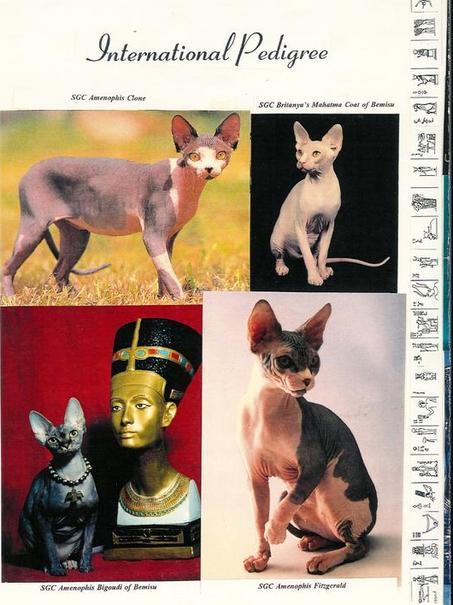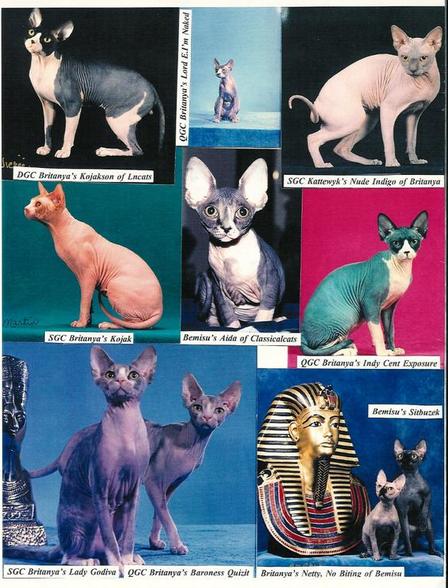Throughout the domestication of the cat, hairless kittens have spontaneously
appeared in Australia, France, Canada and the United States. Around the turn
of the 20th century, there were two hairless cats owned by Mr. J. Schinck in
New Mexico. He had acquired the cats from local Indians. Although there seems
to have been some interest in these cats, no recorded breedings have been found.
Then in 1938, geneticist Professor R. Letard reported two hairless kittens born to
two Siamese cats in Paris, France. Twelve years later in 1950, a Siamese litter of
nine kittens was born, of which three kittens were hairless. When these cats were
interbred, three more hairless kittens were produced, but no further information
is available on breedings using these hairless cats.
The starting point for the Sphynx breed is Ontario, Canada in 1966. A domestic
cat named Elizabeth, produced a hairless male kitten, named Prune. These two
cats, Elizabeth and Prune, were acquired by Ridyadh and Yania Bawa who were
eager to develop this remarkable breed. Keese and Rita Tenhove joined the
Bawas in this breeding of hairless cats that were called at first "Moonstone cats",
then "Canadian Hairless", and finally the name used today "Sphynx".
One of the cats from the Bawa/Tenhove line was acquired by David Mare of San
Francisco. It was acquired from John Royal, a breeder working with the Tenhoves.
The cat, an altered male Sphynx, was named Epidermis. Epidermis was the
catalyst for David Mare's involvement with the Sphynx breed in the United States.
Only two other Sphynx cats of the Bawa/Tenhove program can be traced.
(The Sphynx breed was not eligible for registration in the early days of the
Sphynx history and many small breeding programs may have started and
ended without ever leaving a paper trail. Although with the number of new
mutations showing up one would imagine that some of these new arrivals
may actually be descendants from one of the original breeding programs.)
The last known Sphynx of the Tenhove line ( a female named Dutchie's
Nefertiti) went to Sandy Kaiser of Mewsi-Kal Cattery in 1973. Sandy also had
a male Sphynx, Prune's Napoleon of Bor-Al, which had been bred by the Bawas.
In 1978 two of Dutchie's Nefertiti's kittens went to Dr. Hugo Hernandez in Holland.
The kittens were a male Sphynx, Mewsi-Kal Starsky and a female Sphynx,
Mewsi-Kal Johnny. No other Mewsi-Kal Sphynx cats have been located.
In 1978, Shirley Smith of Toronto, Canada was called upon to rescue two abandoned kittens born to a domestic short hair cat. One kitten was a domestic longhair female and the other was a black and white hairless male Sphynx. Shirley kept the Sphynx kitten, had his injuries treated, and later had him neutered. This Sphynx kitten was named Bambi. The last known information on Bambi is that he ended up living in Aztec Cattery in Canada. He was still alive at the age of seventeen, and may still be alive today.
In 1980, Bambi's mother had two subsequent litters, sired by different males. A female Sphynx kitten was born in each litter. Being that the hairless gene of the Sphynx is recessive to normal coat, the two males used as the studs must have carried the hairless gene and therefore, most likely have been un-recorded descendants of Prunes progeny. The Smiths sent these two kittens to Dr. Hugo Hernandez in Holland. The Smiths named the Sphynx kittens Squeakie and Pinky. These female Sphynx later appeared in Dr. Hernandez's breeding program as Punkie and Paloma.
One additional Sphynx appeared in Canada in the early years of the breed. A hairless farm cat from Western Canada was acquired by Barbara Sutherland of Washington state. This male Sphynx, named Five O'Clock Shadow, has no record of being shown or bred.
Dr. Hernandez attempted to breed the Sphynx male and female that he had acquired from Sandy Kaiser. Mewsi-Kal Starsky successfully bred his sister, Mewsi-Kal Johnny, only once. The kittens from this litter were all lost when the mother rejected them. After Punkie and Paloma were received from Canada, Dr. Hernandez tried breeding Starsky with these new queens. When Starsky did not accept the new Sphynx queens, Dr. Hernandez had him altered in 1981. Paloma went to Hannie Nathans, another Dutch breeder. There Paloma was found to be pregnant by Mewsi-Kal Starsky after all. Unfortunately, Paloma lost this litter, and there were no whole male Sphynx available for the Dutch breeders to use. Dr. Hernandez then decided to use a male Devon Rex in his breeding program. His female, Punkie, was bred to a male Devon Rex named, Curare van Jetrophin. This breeding produced a litter of five kittens.
Another Dutch breeder, Tonia Vink, joined the Sphynx breeding program. She acquired a male Sphynx from the breeding of Punkie and Curare van Jetrophin. He was named, Ra. In 1983, Tonia acquired a female Sphynx, named Hathor de Calecat. Hathor de Calecat was from a litter sired by Ra's litter brother, Ramses. Hathors dam was Paloma. Hathor de Calecat is now owned by Janice Plumb of Amarogue/Shaird Cattery in Enfield, Middlesex, England, where the Sphynx breed is now also being developed.
In 1983, Patrique Challain of Paris bought a litter of five Sphynx from a Dutch breeder. The sire and dam of this litter were Ramses and Paloma. One of the kittens in the litter was Chnoem de Calecat. Then in 1985, Phillipe and Aline Noel of Vaux sur Seine, France, bought two Sphynx kittens from the Dutch breeder, Tonia Vink. The female Sphynx kitten, Ajahanda's Zendila (Mogwai), was out of Ra and Hathor de Calecat. The male Sphynx kitten, Ajahanda's Timothy Atilla (Gizmo), was out of Ra and Ajahanda's Giloesjipa. (Giloesjipa was a daughter of Ra and Hathor de Calecat.)
As mentioned previously, David Mare acquired an altered Sphynx male, Epidermis, out of the Tenhove lines. He also then purchased a female Sphynx from Dr. Hugo Hernandez of Holland. This female was named Alopecia Totalis. His third Sphynx was a hairless male barn cat from North Carolina, named E.T. The last known record of Mare's E.T. showed him to be living in Sacramento, California with Mr. and Mrs. Bill Benson. Unfortunately there are no known offspring from the Mare's Sphynx.
On a final note, Epidermis and Dermis went on to live nice long lives. Dermis died in 1989 at the age of 13, and Epidermis died in 1991 at the age of 16.
In 1985, Carol and Walt Richard's of Britanya Cattery started their own Sphynx breeding program through working with Dr. Solveig Pflueger, TICA Genetics Chair. Their spastic-free Devon Rex female, Britanya's Aida Lott was bred to Chnoem de Calecat (E.T.) from France. This breeding produced four Sphynx kittens. There were two males, (Britanya's Lord E. I'm Naked and Britanya's Gremlin) and two females (Bitanya's Lady Godiva and Britanya's Baroness Quizit). Britanya's Lady Godiva went on to become TICA's first Sphynx ever to reach Supreme Grand Champion status.
Hairless cats found in recent years in domestic cat litters are still being used in Sphynx breeding programs to expand the gene pool. Britanya Cattery has been using a hairless cat's offspring found in Texas. Donna Roberds of Kattewyk Cattery has been using a hairless cat found in Arkansas. A breeding between these two cats produced extremely hairless offspring. Two hairless cats found in Indiana are reportedly being used in other Sphynx breeding programs.
Today there is an ever spreading growth of Sphynx breeders who are dedicated to promoting, educating and raising awareness of these beautiful creatures. But on the flip side to this, there are also those who think there is much money to be made by breeding them “factory style”, with no consideration for conforming to breed standards, hairlessness, or temperament.
*Special thanks to Jon Gour for the extensive research and interviews he conducted for much of the above article.
History of the Sphynx


